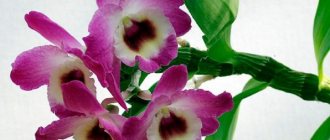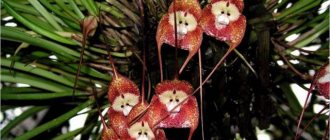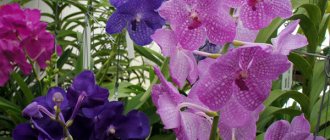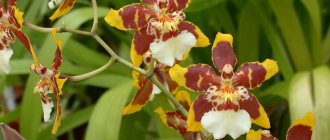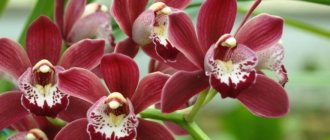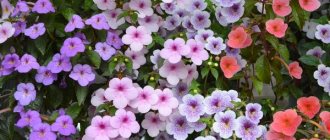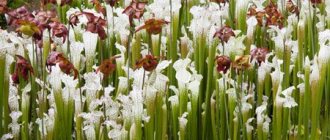Distinctive Characteristics of Bamboo Orchid
In nature, dendrobium Nobile is found in India, Thailand and Nepal. A distinctive feature of the variety is that the buds are formed not one at a time, but in groups. The blossoming flowers are united in numerous inflorescences, and their number depends on the age of the plant.
Read more about the characteristics of the variety, subspecies and colors of Dendrobium Nobile here
general information
This is an epiphytic variety of flowers that grows on trees, but does not parasitize them. The height of the flower is usually up to half a meter. The homeland of this flower is Asia, found in the Himalayas, Indian mountains, Thailand, and Vietnam.
The shoots of this species are erect at the initial stage, then become lodging. Pseudobulbs are large and can reach a length of up to 150 centimeters. The leaves are collected in rosettes and have an oval shape. The flowers are collected in racemes, on which, during flowering, from several to two dozen flowers are formed, the shades of which can be white, orange, yellow or variegated.
There is also dendrobium sanok - a hybrid. Dendrobium sanok is distinguished by white inflorescences and flowers interspersed with pink. Blooms several times a year. The Dendrobium sanok hybrid is rare.
In this article we will talk about caring for the beautiful Dendrobium Nobile at home.
Lighting and location
The Nobile orchid is a light-loving crop, but direct sunlight is harmful to it. Therefore, the pot with the plant is placed on the western or eastern windowsill. If you had to place a flower on a south window, the plant will have to be shaded.
To make the orchid comfortable, the daylight hours should be 12 hours, so in winter the crop is illuminated with special phytolamps.
Find out interesting information about other types of orchids: Odontoglossum, Cymbidium, Vanda, Oncidium, Cambria, Coelogina, Cattleya, Ludisia precious, Miltonia, mini orchids, Brassia
Humidity and watering
There is no universal watering schedule for the Nobile orchid: moisture is added to the substrate as it dries. In summer, watering is carried out 2-3 times a week, in spring and autumn - once every 10 days, and in winter it is almost completely stopped. Read more about the conditions for proper watering for dendrobium here.
How to shower properly?
To ensure that the orchid blooms frequently and profusely, it should be washed periodically in a warm shower. How to water? The water temperature should not exceed +40 degrees. The pot with the plant is placed in a large basin and simply watered for a few minutes. Next, the orchid is left in the container for 30 minutes to allow excess water to drain, and the moisture remaining in the axils of the leaves is thoroughly blotted so that they do not begin to rot.
Read about all the varieties of dendrobuim orchids in this article.
Description
Dendrobium phalaenopsis forms long spindle-shaped pseudobulbs, at the top of which a peduncle is formed.
The lifespan of a pseudobulb is several years, but after the formation of a peduncle, its growth stops, and a new growth point appears at its base. This type of growth is called sympodial.
The pseudobulb bears leathery leaves , which can persist for several years, especially in the upper part, or fall off after flowering.
The arrows in the photo show the pseudobulbs of Dendrobium lindleyi.
The peduncle grows from the top of the pseudobulb and bears up to 40 flowers with a diameter of 3-5 cm , violet, lilac, white, pink or purple. In shape they resemble phalaenopsis flowers.
Features and Specifications
In nature, this species can be found in northern Australia and Papua New Guinea, where it grows on trees and rocks. Due to high air temperatures and humidity, as well as the huge habitat area, the shape and appearance of the plant changes.
The indoor variety of dendrophalaenopsis can reach 120 cm in height. This orchid has a sympodial growth form: spindle-shaped pseudobulbs grow from the rhizome, which store the necessary nutrients and water. Peduncles form on their upper part, after which the pseudobulbs stop growing, and new growth sites form at their base. Peduncles can have up to 40 flowers, formed from eight petals, their diameter can be from 3 to 7 cm. Flowering is abundant, lasts several months, the color range varies from snow-white to pink, purple and deep violet.
The stem contains from 2 to 15 dense elongated leaves with a notch in the middle. At the bottom they are smaller and quickly fall off, but at the top they are larger and can grow for 2-3 years. The color of the leaf blades is dark green.
Dendrobium phalaenopsis in nature: habitat, area of distribution
This species is native to the northern regions of Australia and Papua New Guinea . Dendrobium phalaenopsis can grow epiphytically (on trees) or lithophytically (on rocks), rising to a height of 400 m above sea level. The habitats maintain relatively high temperatures and air humidity throughout the year. Moreover, due to the large area of distribution, the appearance of plants varies greatly.
Distinctive features
It is difficult to identify distinctive features, because... The height of plants, the number of leaves on pseudobulbs, their life expectancy and the color of flowers can vary greatly. All plants are characterized by leathery dark green leaves, located mainly in the upper part of the pseudobulb.
The number of leaves varies from 3 to 15, depending on the size of the pseudobulbs. At the same time, they grow on the entire stem, which is why Dendrobium phalaenopsis is often called “tree orchids” (you can see the photo below).
Dendrobium phalaenopsis.
Subtleties of classification
An interesting fact is that this species has become widely known under a name that is actually synonymous with its real name. This type of orchid was first discovered in 1852 and was named Dendrobium bigibbum, but thirty years later (in 1880) another researcher also discovered a plant of this species in another region and, not knowing about the previous discovery, named it Dendrobium phalaenopsis (Dendrobium phalaenopsis).
On a note! The term Dendrobium phalaenopsis has now become an impersonal name for a huge group of hybrids, similar in external structure, type of growth and originating from D. bigibbum. The real species name is known mainly to collectors.
Is there a difference between Phalaenopsis and Dendrobium?
The specific species name often discourages flower growers who are not familiar with the intricacies of the classification of orchids. Dendrobium and Phalaenopsis are actually 2 different genera of orchids , each with a huge number of species.
Dendrobium phalaenopsis is a member of the genus Dendrobium, and it received its specific name not because of its relationship with phalaenopsis, but because of the similar appearance of the flowers.
In addition, due to the similarity in pronunciation, dendrobium is sometimes mistakenly called “arboretum”. To avoid confusion, let's say that an arboretum is an area allocated for the cultivation in open ground of woody plants (trees, shrubs, vines), located according to systematic, geographical, ecological, decorative and other characteristics (definition from Wikipedia). That's why you will never see orchids in the arboretum, even in photos.
What to do next after flowering?
When the Nobile orchid has bloomed, the question arises: what to do next? Yellowed pseudobulbs are not immediately removed, as they serve as a source of nutrients for young growing bulbs. They are cut off only after complete drying, and the cut areas are sprinkled with crushed coal. Next, the orchid is transferred to a cool room with a temperature no higher than +20 degrees during the day and +12 at night.
Read more about caring for the plant during and after flowering here.
What kind of soil is needed?
To transplant Nobile orchids, use special purchased soil for epiphytic plants.
You can prepare the substrate yourself:
- Pieces of pine bark 1–3 cm long are used as a base. First, it is dried and then boiled several times to clean it from fungi and viruses.
- Pieces of charcoal are added to the bark, which will prevent soil acidification and root diseases.
- You can also add some coconut fiber or crushed bottle caps to make the substrate looser.
If you plan to place the orchid on a south-facing window, you should add a little sphagnum moss to the soil, which will help retain moisture.
What should I plant it in?
To make the orchid comfortable, you should choose the right pot for it. It should be high enough to accommodate a 3–4 cm layer of drainage at the bottom. It does not have to be transparent, since the dendrobium root system does not take part in photosynthesis.
According to the material, the pot can be clay or ceramic.
But it is better to choose the latter option, since ceramic pots have drainage holes not only in the bottom, but also in the walls, which improves air flow to the roots.
Home care
In nature, Dendrobiums are plants with a pronounced seasonality. Their development cycle includes periods of active growth, flowering and dormancy. And for each such time period you will have to create your own conditions in your home.
The Dendrobium Nobile orchid constantly develops throughout the year. Four conventional periods of her life can be distinguished:
- Vegetation . At this time, new shoots appear at the base of old pseudobulbs (babies).
- Formation of new pseudobulbs . The young sprout develops and catches up in size with the old pseudobulb, i.e. itself becomes a pseudobulb.
- The period of laying peduncles . At this time, the plant is in a dormant period.
- Bloom . At this time, flowers bloom on the peduncles. Different hybrid varieties have different durations of this period.
Let's consider the basic rules for caring for the Dendrobium Nobile orchid at different periods of its life.
Lighting and flower location
It is known that the light-loving orchid does not tolerate direct sunlight well, although without bright, but diffuse sunlight for 12 hours a day, it is even worse. Therefore, when choosing a place for a pot, pay attention to the windowsills in the eastern or western direction. It is also possible to grow in the south, provided that the plant is protected from the rays of the midday sun scorching through the glass using light blinds or curtains. When growing a flower near northern windows, you will need to use artificial sources of daylight so that the orchid does not suffer from lack of light. Outdoors during the summer months it thrives in both light shade and sun. The brighter and longer the lighting, the more abundant and colorful it will bloom. Pay attention to the leaves. If they are too dark, there is not enough light. If the leaves of a plant are too light on a sunny windowsill, they will burn through the glass and may get sunburned. The Dendrobium Nobile orchid should have lush green leaves.
Temperature
Optimum room temperature during the day: in summer 22 – 28 degrees. and 15 – 20 gr. in winter. This orchid easily tolerates fairly high temperatures, up to 32 degrees, with comfortable ambient humidity. To stimulate flowering, the plant needs a difference between day and night temperatures within 5 - 10 degrees. Temperatures below 15 degrees are considered critical for summer. at night and above 33 degrees. during the day.
During flowering, it is advisable to reduce the temperature and maintain about 18 degrees. – then the flowering itself will last longer.
If Dendrobium Nobile is kept outdoors (in the garden, on the veranda), the difference in daily temperatures will occur naturally. If the flower is kept indoors all year round, at night, to reduce the temperature, you need to ventilate the room well, if necessary, turn off or block the heating devices, do wet cleaning and spraying.
This may be interesting: Diseases and pests of the Phalaenopsis orchid
With the onset of autumn, the temperature of the flower should be reduced to 20 - 22 degrees. in the afternoon and about 16 degrees. at night.
Watering Dendrobium Nobile
Sometimes the room is dry and hot, and sometimes it’s cool and damp. Focus on the microclimate in which your flower has to live. Dendrobium Nobile is watered as often as its substrate requires. If it dries out, it needs another watering. In summer this happens two to three times a week, in spring and autumn - once every 10 to 15 days. During the dormant period, the flower may stop consuming moisture altogether and is practically not watered until new flower shoots appear.
Water for irrigation is used that is soft, clean, warm, filtered or settled for 24 hours and heated a couple of degrees above room temperature. You can use boiled water after it has cooled to a temperature a couple of degrees higher than the air in the room.
Watering is carried out in different ways. It is best to place the flower pot in a bowl of filtered warm water so that only the lower part of the pot is in the water. Within a few minutes, the substrate will be thoroughly saturated with moisture, and the pot can be removed and placed in a tray to drain excess liquid. We recommend combining such watering with fertilizing by adding liquid fertilizers for orchids to the water.
You can simply add water to the pan during the next watering until it stops being absorbed into the substrate. Then after 20 - 30 minutes, excess moisture must be drained from the pan.
At the end of the growing season, while preparing the Dendrobium for flowering, reduce watering by half and stop feeding. At this time, we recommend periodically giving the orchid a bath in a hot shower with a water temperature of 35–40 degrees. After an evening bath, blot water in the axils of the leaves to prevent the trunk from rotting.
Such bathing will not only clean the leaves of the plant, but also improve gas exchange in its tissues and stimulate future flowering. When flower buds appear, watering and feeding should be resumed.
Humidity
Dendrobium Nobile orchids grow best in normal and high ambient humidity. The minimum permissible humidity limits are 40% - 50%. Hot, dry weather slows down the growth of an orchid, and sometimes stops it altogether. It is better if the humidity is higher. To increase it, wet stones, moss, and large pieces of pine bark are placed in the tray. Do not place the pot in water, so as not to cause rotting of the roots. To retain moisture in the pot, cover the surface of the substrate with moss. Frequent spraying with a fine spray bottle is used both on the bush and in the surrounding air. This is especially true for hot summer days and with the onset of the heating season.
Soil for Dendrobium Nobile
To plant and replant Dendrobium Nobile, use purchased soil for orchids or epiphytic plants. It’s also not difficult to prepare the substrate yourself if you live near a pine forest. The basis of the soil for orchids are pieces of old pine bark measuring from 1 to 3 cm, which must first be thoroughly dried and then boiled in water a couple of times to ensure that it is cleaned of any fungi and viruses. It is also necessary to add pieces of charcoal to the substrate to prevent soil acidification and root diseases. You can add fern roots if you have them, bottle caps, coconut fiber. If your flower is on a south-facing window, you should add pieces of sphagnum moss to the substrate - it will retain moisture.
If the pot is placed on a north-facing window, then small pieces of polystyrene foam should be added to the substrate to loosen it further. The presence of a small amount of peat in it has a positive effect on the quality of the soil. This is a slightly strange substrate that orchids love. It does not serve to obtain nutrients, but rather to secure the Dendrobium roots in the pot and provide better ventilation. We recommend pouring boiling water over the substrate you prepared yourself, letting it sit for about 15 minutes, then draining the water and waiting for the soil to dry. Now the soil is ready for use.
Transplanting Dendrobium Nobile and choosing a pot
Dendrobium Nobile does not need frequent replanting into a new pot and new substrate. He does not tolerate changes in environment and conditions of detention. Even after purchasing an orchid, it is transplanted into a new pot next spring, not earlier. A healthy plant will need the next transplant in three to four years. In addition, Dendrobium Nobile feels better in a cramped pot when the gap between the roots and the walls of the pot does not exceed 2 cm.
Transplantation is only necessary in a few cases. And then they try to carry it out only after flowering has ended:
- The substrate turned to dust. The roots have nothing to grab onto and do a poor job of holding the flower in the pot.
- The root system filled the entire space in the pot and displaced all the substrate from it. The roots are sticking out. The pot became clearly too small.
- If you notice a brown coating, rot, or the soil has become salty on the rhizome, then do not wait for trouble and, without waiting for the end of flowering, transplant the flower into a new substrate, having previously cut off the damaged and diseased parts of the root.
So, for replanting, prepare a pot of the required size.
It should be quite high so that, in addition to the plant, it can accommodate a layer of drainage of at least three to four cm made of heavy, large, but sterilely clean stones. This is necessary so that the orchid, having a relatively weak root system and heavy, fleshy leaves, cannot overturn the pot.
The pot does not have to be transparent, since the root system of Dendrobium Nobile, unlike Phalaenopsis, does not take part in photosynthesis.
It should correspond to the size of the root system of Dendrobium Nobile and be 2 cm larger than the diameter of the previous one. Do not forget that the flower prefers a cramped pot.
It is better if the pot is made of clay with good drainage holes. On sale you can find special pots for orchids made of ceramics, which have holes not only in the bottom, but also in the walls, which significantly improves gas exchange in the root system. Before use, we recommend calcining such a pot in the oven, cooling and then soaking for two hours in clean water. The pot is now ready to use.
Place a layer of drainage on the bottom of the pot. For drainage, in addition to stones, use the largest pieces of pine bark measuring 3 - 4 cm. We recommend not using expanded clay as drainage, since it contains calcium, which will salt the substrate.
Remove the flower from the old pot and completely clean the roots from the substrate. To better remove the soil, soak the root system in a basin of warm water. This way you can easily clean the roots without damaging them. If you do see damaged or broken roots, cut them with a clean, sharp knife and treat the sections with activated carbon. Hold the roots in the air - let them dry out and heal the wounds.
Now you can place the orchid roots in the center of the new pot on the drainage layer, and cover them with new substrate. If the plant is large and needs support, it’s time to install it and tie the flower to the support. Do not compact the soil. It’s better to shake the pot a little so that all the voids between the roots and the walls of the pot are filled. Do not cover young pseudobulbs with substrate so that they do not rot during watering. It is advisable to leave 2–3 cm to the top edge of the pot, in case the rhizome grows, so that you can add substrate. For a couple of weeks after transplantation, set the flower aside from sunlight, let it stand in partial shade at a temperature of about 20 degrees. Do not water it for three days, let possible wounds on the roots heal. If old leaves begin to turn yellow, don’t worry, their lifespan has expired. The orchid will get used to the new substrate and grow new ones.
Growing an orchid on a block
In addition to the pot, blocks are used to grow Dendrobium Nobile, on which orchids also grow well. Blocks are special materials to which this orchid can be attached. These can be hanging baskets made of slats, decorative supports in the form of driftwood. The block can be pine bark, cork oak bark, or a tree fern block. Methods of growing Dendrobium on blocks have recently become popular
This may be interesting: Reproduction of Phalaenopsis orchids at home
Top dressing
Orchids, in particular Dendrobiums, love regular feeding. From soil that is poor in composition, roots cannot extract mineral salts and other elements useful for healthy growth. Therefore, special fertilizers for orchids are used only in the form of liquid solutions. When watering the roots of Dendrobium Nobile, they are added to a tray or basin with water in doses reduced by 2 times from those recommended by the manufacturer, and during foliar feeding, when spraying the leaves with a small spray bottle, the dose of the drug is reduced by 5 times.
It is important to remember that in Dendrobium Noble, not only growth buds awaken in the spring, but also flower buds. Feeding with fertilizers, which contain a lot of nitrogen, can lead to the formation of a large number of new rosettes - babies. If you continue to feed the orchid with them, you may not wait for flowering. Therefore, when the sprouts grow to half their size, change the fertilizer to one that contains more phosphorus than nitrogen.
We strongly do not recommend placing fertilizers in tablets or granules dry into the substrate. We also do not recommend using homemade fertilizers or using folk remedies as them. Orchid roots are very delicate and sensitive; from an overdose they can burn, get sick or die. Is it worth the risk?
Dormancy period and preparation of Dendrobium Nobile for flowering
Surprisingly, different gardeners in different places have Dendrobium Nobile orchids bloom at different times of the year. This depends on the growing conditions and varietal characteristics of the hybrids. And there are currently an incredible variety of hybrid forms of Dendrobium Nobile!
The plant must prepare in advance for each flowering. And, the main thing here is a well-organized rest period for Dendrobium Nobile. It is at this time that the plant begins to prepare for the next flowering.
The Dendrobium Nobile orchid has bloomed, what to do next? Do not remove yellowed old pseudobulbs immediately. They will also serve as food for young growing bulbs. Only cut them off when they are dry. Sprinkle the cut areas with crushed coal.
Move the pot to a cool room. The temperature during the day should be between 16 - 20 degrees, at night - about 10 - 12 degrees. In the southern regions, it can easily winter on a glassed-in loggia if the temperature there at night does not drop below 10 degrees.
Reduce watering and then stop altogether. Feeding too. If the pseudobulbs are severely wrinkled, lightly spray the substrate and leaves of the flower. It is not necessary to create artificially high air humidity during this period.
Watch the flower. After about a month, with the onset of spring, when night temperatures rise, the plant begins to emerge from hibernation. Flower buds should appear in the internodes of the orchid's pseudobulbs. Young pseudobulbs will begin to turn into flower stalks. Now you can take the pot to its permanent place in the sun.
From early spring the flower should be illuminated as brightly as possible. The temperature difference between day and night should be at least five degrees. Watering should be plentiful, with the substrate thoroughly drying between waterings. Feeding is moderate. Fulfillment of these conditions guarantees you gorgeous flowering.
The flowering period lasts from a month to two. The ambient temperature plays a big role here. The higher it is, the faster the orchids will bloom. The ideal temperature for flowering is 18 degrees.
What to do with Dendrobium Nobile after flowering? At the moment when flowering ends, the above-ground part of the plant enters the phase of active growth, which over time leads to the formation of new rosettes - children. Green mass is growing until the end of August. You should not touch old pseudobulbs, because they will provide additional nutrition to young, newly emerged children.
Transfer
The dendrobium Nobile orchid does not need to be replanted too often, as it does not tolerate the procedure well.
A transplant is necessary in the following cases:
- The substrate deteriorated and turned into dust. In this case, it is completely replaced, and the flower is transplanted into a new pot.
- If the orchid's roots stick out above the substrate, this means that the container has become too crowded and the plant needs to be moved to a larger pot.
Transplantation is carried out after flowering has completed. But, if rot or brown plaque appears on the roots, they do not wait for the end of flowering and immediately replant the plant.
For detailed step-by-step instructions for transplanting dendrobium, see here.
After the purchase
Immediately after purchase, the Nobile orchid does not need to be replanted. The procedure is carried out only next spring. The next transplant will be required no earlier than in 3–4 years.
Expert advice on growing Dendrobium nobile
The period of growth of new pseudobulbs is a critical time. It is only conventionally called “rest,” but in fact the plant does a lot of work. Maintaining a strict balance of humidity, light, air temperature and fertilizing at this time is of particular importance:
“Beginners tend to “forget” about an orchid when it stops blooming. Meanwhile, it is in the “off-season” that the foundation for future flowering is laid. It is very important at this moment to reduce the moisture content of the substrate, but maintain good air humidity (about 50%). If the air is too dry, the leaves on young pseudobulbs will begin to grow deformed and will not be able to fully perform their function. This will, of course, reduce the quality of flowering.”
L. Semich, orchid collector, landscaper
Reproduction by children
There are several ways to propagate the crop: by children, cuttings, using a young pseudobulb or dividing an adult bush.
The most effective way of reproduction is by children. Let's take a closer look at how to propagate a flower using this method:
- Over time, the orchid's pseudobulb forms a rosette instead of a flower. This is the baby from which you can get a young plant.
- When the sprout is formed and strengthened, it is separated with a sharp, disinfected knife or pruning shears. The cut area is sprinkled with crushed coal.
- To make the wound on the cut heal faster, the baby is left in the open air for several hours.
After this, the sprout is transplanted into a pot with a substrate, and to create a greenhouse effect, the crop is covered with film or a jar. As a rule, the baby takes root quickly, but begins to bloom only next year.
You can find out about other possible ways to propagate dendrobium here.
Diseases and pests
Improper care can cause orchid diseases. For example, if dry brown spots appear on the leaves, the flower has received sunburn, so the plant should be protected from direct sunlight.
Wet spots on leaves and roots indicate the beginning of rot. Such a flower must be removed from the old substrate, carefully trim off the damaged areas, transplant the flower into a new pot and stop watering for a while.
Pests on the orchid may include thrips, scale insects, aphids or spider mites.
To combat them, special insecticides are used, and for prevention, the leaves of the plant are regularly washed in the shower.
Possible problems and their solutions
Despite the fact that the Nobile orchid is considered an unpretentious plant, certain problems may arise during its cultivation.
Why doesn't it bloom and how to make it?
If the crop does not bloom in due time, it is quite possible that it does not have enough sunlight and it is better to move the pot closer to the window.
In addition, a full period of rest without watering, fertilizing and growing in a cool room is extremely important for the flower.
An excess of nitrogen fertilizers should not be allowed. Because of this, new growth shoots are formed on the plant, rather than flower buds, so it is better to use complex preparations for feeding.
The leaves are turning yellow
Yellowing of leaves is a natural aging process. They are updated every 2 years, so there is no need to worry about this. If the leaves not only begin to turn yellow, but also become covered with wet spots, you should be concerned.
Rot begins due to stagnation of water in the axils of the leaves or after spraying at low temperatures. To prevent this from happening, after a shower, the orchid leaves are dried, and all rotten places are cut out from a badly damaged flower and transplanted into a new substrate.
Air temperature for Dendrobium nobile
Dendrobium nobile is a “cold-kept” orchid. Normal formation of flower buds occurs only in a cool microclimate. The optimal temperature range for dendrobium depends on the time of year:
- in spring and summer: during the day +22-250С, at night +18-200С;
- in winter and autumn: during the day +18-200С, at night +13-150С.
Changes between day and night temperatures are physiologically necessary for orchids. In their absence, dendrobiums are in no hurry to begin flowering.
Important! If the air temperature is too high, babies begin to grow on pseudobulbs instead of flowers. Therefore, if there is a goal to propagate dendrobium by children, you can use this feature of the plant and keep it in a humid, hot room.
